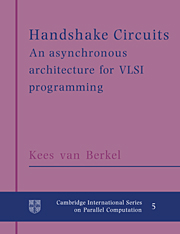Book contents
- Frontmatter
- Contents
- Foreword
- Preface
- 0 Introduction
- 1 Introduction to Tangram and handshake circuits
- 2 Examples of VLSI programs
- 3 Handshake processes
- 4 Handshake circuits
- 5 Sequential handshake processes
- 6 Tangram
- 7 Tangram → handshake circuits
- 8 Handshake circuits → VLSI circuits
- 9 In practice
- A Delay insensitivity
- B Failure semantics
- Bibliography
- Glossary of symbols
- Index
Preface
Published online by Cambridge University Press: 14 January 2010
- Frontmatter
- Contents
- Foreword
- Preface
- 0 Introduction
- 1 Introduction to Tangram and handshake circuits
- 2 Examples of VLSI programs
- 3 Handshake processes
- 4 Handshake circuits
- 5 Sequential handshake processes
- 6 Tangram
- 7 Tangram → handshake circuits
- 8 Handshake circuits → VLSI circuits
- 9 In practice
- A Delay insensitivity
- B Failure semantics
- Bibliography
- Glossary of symbols
- Index
Summary
This book is about the design of asynchronous VLSI circuits based on a programming and compilation approach. It introduces handshake circuits as an intermediate architecture between the algorithmic programming language Tangram and VLSI circuits.
The work presented in this book grew out of the project “VLSI programming and compilation into asynchronous circuits” being conducted at Philips Research Laboratories Eindhoven, since 1986. Our original motivation was to increase the productivity of VLSI design by treating circuit design as a programming activity. We chose asynchronous circuits as target for automatic silicon compilation, because asynchronous circuits simplified the translation process and made it easier to take advantage from the abundantly available parallelism in VLSI. Later we discovered that the potential for low power consumption inherent in asynchronous circuits may turn out to be highly relevant to battery-powered products.
The core of this book is about handshake circuits. A handshake circuit is a network of handshake components connected by handshake channels, along which components interact exclusively by means of handshake signaling. It presents a theoretical model of handshake circuits, a compilation method, and a number of VLSI-implementation issues. This core is sandwiched between an informal introduction to VLSI programming and handshake circuits on the one side and a discussion on practical experiences including tooling and chip evaluations on the other side.
- Type
- Chapter
- Information
- Handshake CircuitsAn Asynchronous Architecture for VLSI Programming, pp. xi - xivPublisher: Cambridge University PressPrint publication year: 1994



